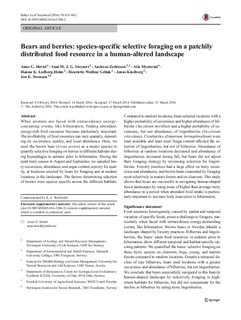Bears and berries: species-specific selective foraging on a patchily distributed food resource in a human-altered landscape
Hertel, Anne Gabriela; Steyaert, Sam; Zedrosser, Andreas; Mysterud, Atle; Lodberg-Holm, Hanna Kavli; Gelink, Henriette Wathne; Kindberg, Jonas; Swenson, Jon
Journal article, Peer reviewed
Published version
Permanent lenke
http://hdl.handle.net/11250/2500731Utgivelsesdato
2016Metadata
Vis full innførselSamlinger
Originalversjon
Behavioral Ecology and Sociobiology. 2016, 70 (6), 831-842. 10.1007/s00265-016-2106-2Sammendrag
When animals are faced with extraordinary energyconsuming events, like hibernation, finding abundant, energy-rich food resources becomes particularly important. The profitability of food resources can vary spatially, depending on occurrence, quality, and local abundance. Here, we used the brown bear (Ursus arctos) as a model species to quantify selective foraging on berries in different habitats during hyperphagia in autumn prior to hibernation. During the peak berry season in August and September, we sampled berry occurrence, abundance, and sugar content, a proxy for quality, at locations selected by bears for foraging and at random locations in the landscape. The factors determining selection of berries were species specific across the different habitats. Compared to random locations, bears selected locations with a higher probability of occurrence and higher abundance of bilberries (Vaccinium myrtillus) and a higher probability of occurrence, but not abundance, of lingonberries (Vaccinium vitis-idaea). Crowberries (Empetrum hermaphroditum) were least available and least used. Sugar content affected the selection of lingonberries, but not of bilberries. Abundance of bilberries at random locations decreased and abundance of lingonberries increased during fall, but bears did not adjust their foraging strategy by increasing selection for lingonberries. Forestry practices had a large effect on berry occurrence and abundance, and brown bears responded by foraging most selectively in mature forests and on clearcuts. This study shows that bears are successful in navigating human-shaped forest landscapes by using areas of higher than average berry abundance in a period when abundant food intake is particularly important to increase body mass prior to hibernation. Significance statement Food resources heterogeneity, caused by spatial and temporal variation of specific foods, poses a challenge to foragers, particularly when faced with extraordinary energy-demanding events, like hibernation. Brown bears in Sweden inhabit a landscape shaped by forestry practices. Bilberries and lingonberries, the bears’ main food resources in autumn prior to hibernation, show different temporal and habitat-specific ripening patterns. We quantified the bears’ selective foraging on these berry species on clearcuts, bogs, young, and mature forests compared to random locations. Despite a temporal decline of ripe bilberries, bears used locations with a greater occurrence and abundance of bilberries, but not lingonberries. We conclude that bears successfully navigated in this heavily human-shaped landscape by selectively foraging in highreturn habitats for bilberries, but did not compensate for the decline in bilberries by eating more lingonberries.Bilberry . Brown bear . Lingonberry . Movement trajectories . Optimal foraging . Sugar content

